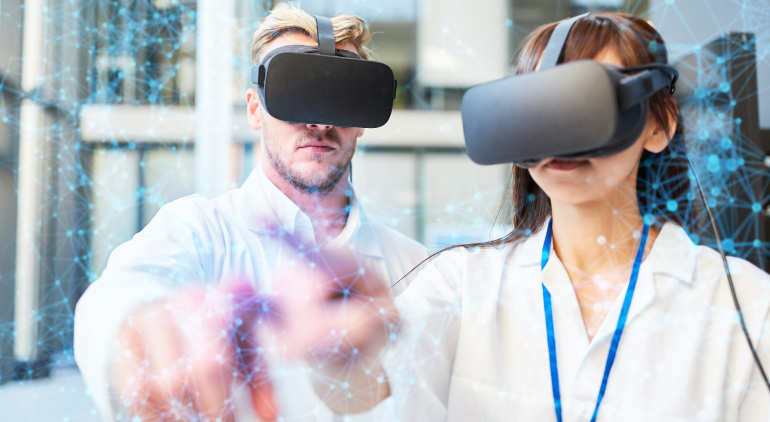Radiology, often known as diagnostic imaging, is a set of procedures that involves taking photos or images of body parts. Diagnostic radiology and interventional radiology are two fields of radiology that employ radiant energy to diagnose and cure disorders.
Some of the most common types of radiology exams is:
• Computed tomography (CT) and computerized axial tomography (CAT) scan
• Magnetic resonance angiography (MRA) and Magnetic resonance imaging (MRI)
• Plain x-rays
• Mammography
• PET imaging, PET scan, or PET-CT
• Ultrasound
Radiology is classified depending on the type of radiology and the imaging test used to treat a wide range of diseases.
• The Radiology Market was valued at $9.7 billion in 2020 and is expected to grow at a CAGR of 10.7% from 2021 to 2028, reaching $21.8 billion by 2028.
Virtual Reality in Healthcare
Healthcare is one of the most enthusiastic users of virtual reality, with applications ranging from robotic surgery to phobia therapy, surgery simulation, and skill training, to mention a few. Many healthcare institutions around the world have begun to use VR Assisted Vision Therapy in their operations and have seen the benefits.
• Healthcare Market was estimated at $2.076 Billion in 2020 and it is speculated to touch $42.84 Billion by the year 2028, at a CAGR of 39.98% for the duration of 2021 to 2028.
In the realm of medicine, virtual reality is used in a variety of applications. Patient therapy, medical marketing, and educating people about a disease, medical condition, or process are all forms of medical training for both students and doctors in training.
Virtual Reality in Radiology
Virtual reality is a novel and transformative concept, and its advancement in the realm of medical diagnosis is pushing this technology to new heights. Virtual reality simulators provide crucial skills for practicing in a controlled environment and operating patients with less supervision.
Virtual reality has the potential to revolutionize the way radiologists examine pictures and where they view them. 3D imaging may become common practice as VR pictures improve, giving radiologists more freedom by eliminating the requirement for a workstation. Radiologists can use virtual reality headsets to see virtual reality pictures, allowing them to view images from practically anywhere.
In Radiology, Virtual reality can be used to explain medical procedures to patients in some hospitals and clinics. Simulating a hospital atmosphere or leading patients through the steps of a procedure can help patients relax and gain a new perspective, while also improving awareness and demystifying confusing medical terminology.
Virtual reality can make a patient feel more at ease by simulating a radiological procedure Patients can use virtual reality to familiarize themselves with procedure suits and recovery rooms.
Virtual reality is an excellent tool for radiology students. Radiology students, residents, and radiologists can study 3D scans in real-time using VR-based systems treatment. They can also interact with the image and edit it so that it can be viewed from a variety of angles.
Students may witness interventional procedure suites using stereoscopic viewers attached to their cell phones. These interactive lectures are aimed to present students with a scenario before asking them a series of management questions.
Conclusion
Although the application of virtual reality in radiology is still in its infancy, it is likely that virtual reality will play a significant part in diagnostic radiography in the not-too-distant future.
This tendency could lead to more individualized and personalized therapies and diagnostics.
For more information about current trends and Virtual reality suites, you can visit our website Cognihab.com


